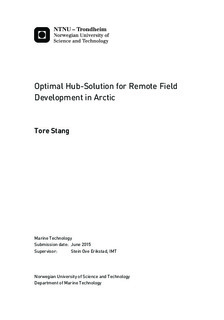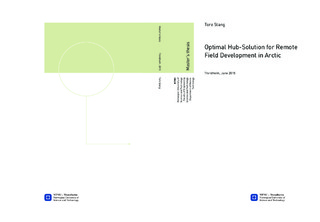| dc.description.abstract | This report present a new solution method to analyze usage of hub-vessels in upstream logistics for remote fields.
The objective in this thesis is to analyze which parameters that affect the logistics chain for remote fields in the Barents Sea. Usage of hub-vessels to centralize the flow, and hence take advantage of economies of scale are analyzed and compared to a conventional supply chain.
An initial supply problem in the Barents Sea is designed to be able to examine the logistical chain. Parameters in the problem, such as demand, capacity, speed of vessels and supply frequency at the installations are based on supply problems described in the literature. In conventional offshore supply problems, are commodities and special equipment transported directly from base to installations by usage of PSVs. In the hub-solution are two bigger vessels (hub-vessels) used to transport the supplies to a given location in the Barents Sea, where they connect to a buoy and function as a forward placed base. The two hub-vessels switch between functioning as a forward placed base and transporting supplies between base and hub-position.
The report presents a solution method where optimal solutions for numerous different test cases are obtained and compared. An optimization model finds optimal fleet composition for problems with and without hub-vessels, by minimizing the total cost. The planning period for all problems are two weeks, and it is assumed that the optimal schedules are repeated every two weeks. The mathematical model used in the analysis is inspired by the model presented in (Fagerholt, 2000). First, three to six installations are generated with random location inside an installation matrix. The initial installation matrix span from 15°E to 37°E and 71°N to 74°N. The installation matrix is moved 2°N (four times) after optimal solution for 50 problems are obtained and saved. The installations are generated with a given random seed in Matlab, to make it possible to compare and reproduce the results. Finally, the results are analyzed by plotting optimal solution for all cases against distance from shore.
Based on guidelines and results from the model will optimal position for hub-vessels approximately be 75% of the distance between base and installation-centroid. This will increase the range for helicopters transporting people to the offshore installations by approximately 50%, without violating current guidelines. It is recommended that the hub-vessels connect to an anchored buoy when serving as a forward placed base in the Barents Sea. This ensures quick and easy abandonment of position if needed due to drifting icebergs or bad weather.
For the initial cases with three to six installations, the hub-solution will represent a higher cost than the conventional solution, regardless of distance from shore. To supply a field with six installations located approximately 500 nautical miles from shore, a fleet with two hub-vessels and two PSVs is needed, or a fleet with four PSVs for direct shuttle between base and installations. Increased distance, demand, number of installations and frequency of visits decreases the cost difference between the two solutions. The cost of the two solutions are comparable for a hypothetical problem where the installations are visited seven times a week. Analysis of the hub-solution shows that two-vessels are needed for all problems in addition to one, two or three PSVs, depending on the spread of the field and the number of installations.
The results show that the hub-solution is only cost efficient in a few special cases. Further analysis of all advantages and drawbacks including hub-vessels should be done. Detailed design considerations of the hub-vessels is needed to lower the uncertainty represented in the charter costs. This would be applicable for a case study, where demand and requirements are known. | |

